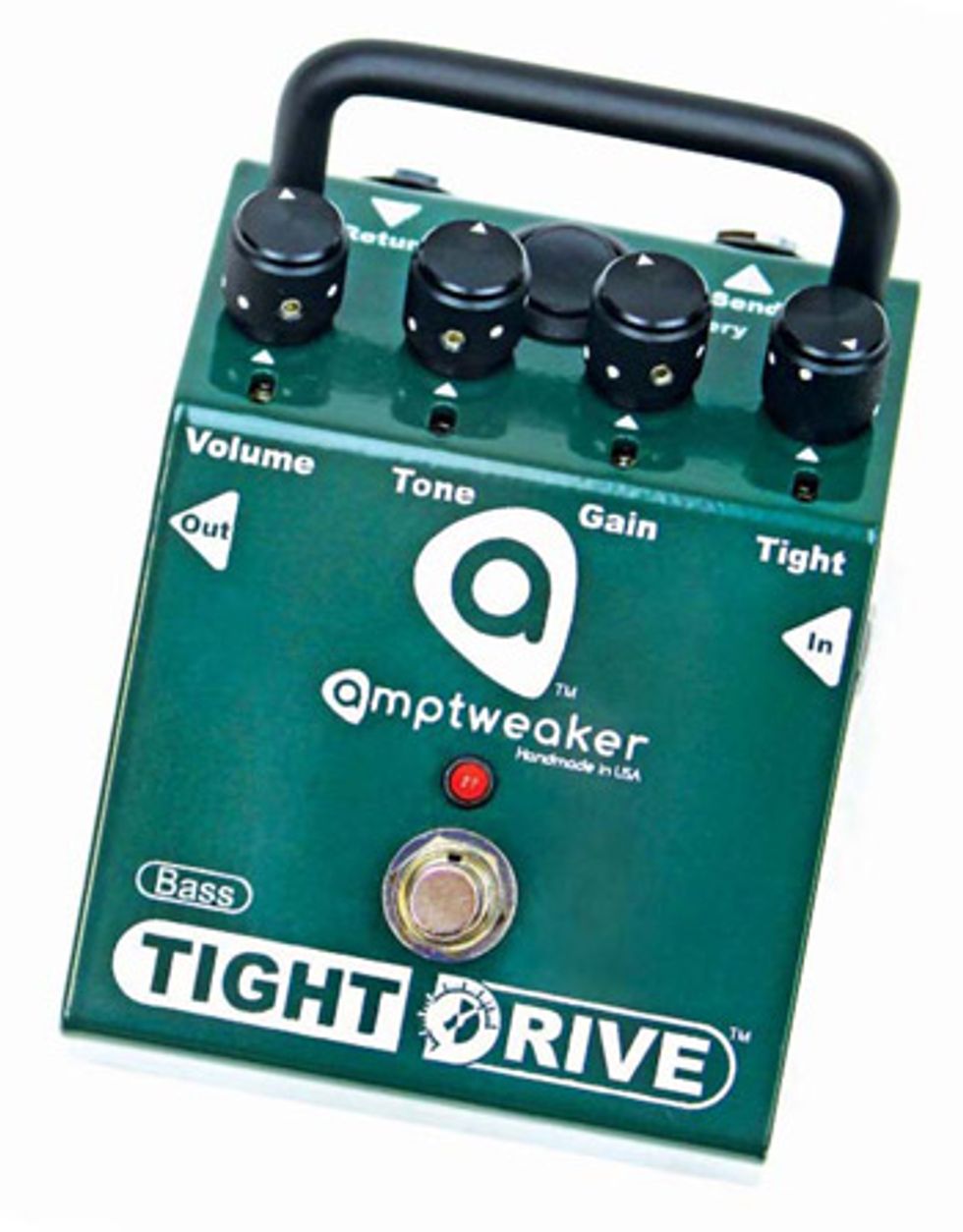Amp guru James Brown''s debut pedal is tweaked for bass
The Bass TightDrive was born after amp guru
James Brown met Greg Weeks, bassist for the
metal outfit the Red Chord, at the January
2010 Winter NAMM show. Weeks played the
TightDrive guitar model and, based on the
extreme settings he seemed to favor, Brown
suggested making some circuit alterations to
better accommodate his playing style.
The Bass TightDrive’s controls are identical to
the guitar model. The basic setup of Volume,
Tone, Gain, and Tight controls are still there,
nestled securely on the pedal’s rear flank.
Behind the knobs is a sturdy metal roll bar,
which covers a rocker switch that disengages
the 9-volt battery circuit. This is handy for
players who use batteries, but don’t want
to unplug the unit on their pedalboards
when they’ve finished playing. The sturdy,
14-gauge steel chassis feels substantial and
offers a magnetically latched battery door
that slides out from the side. A simple solution
to a common problem, this is one of the
best ideas I’ve seen in a pedal in a long time.
I realize cost is a consideration for pedal
designers, but every battery-powered pedal
should provide tool-free access to the battery
compartment. For those who hate having
to reach for a screwdriver every time they
change a cell, the Bass TightDrive’s battery
door is a godsend.
The Tight control on the standard TightDrive
offers a multitude of distortion flavors, mostly
affecting the amp’s attack and response. With
the Bass TightDrive, the Tight control presents
a whole new way of helping the bass fit
in the overall mix. The adjustment knob still
allows the player to fine-tune the amplifier’s
attack, but since bass serves an entirely different
purpose of filling out and supporting
the rhythm section, the control comes into
play in a very different way.
Plugging In
I tested the Bass TightDrive using a 1987
Kramer USA Striker bass plugged into a
Gallien-Krueger 700RB head. My cabinet, a
1970 Orange 8x10 with Ampeg SVT speakers,
really allowed the whole rig to open
up and clearly reveal the Bass TightDrive’s
capabilities. With the Tight control turned
fully counter-clockwise, the low end was very
expansive. My notes carried across the room
quite well when I played at the lower end of
the fretboard.
As I turned the Tight control up, the low end
decreased steadily and the midrange slowly
started to creep out, along with sharper
high-end frequencies. For a standard guitar,
this feature would probably be most useful
for adding sting to notes in a lead passage,
but with bass it offers a whole new world
of texture. Hard rock and metal bassists are
often left out in the cold in the final mix, and
their lines are often hard to hear. The Tight
control allowed me to adjust exactly where I
sat in the mix with my band, whether or not I wanted a really fat, rounded tone à la Jack
Bruce, or a more aggressive, punchy one in
the vein of Motörhead’s Lemmy Kilmister. I
was astonished at how much influence that
control had over my tone, and it was really
fun digging in and seeing how far it would
take me. It was as if I could choose my own
voicing for the pedal. If the low end wasn’t
present enough, all I had to do was turn it
up on the amp. Having the Tight control up
too high did create some feedback, though.
Carefully balancing the Gain and Tight controls,
in tandem with not dialing in too much
low end on the amp, helped keep the feedback
in check.
Looping
Brown also included another cool feature
from the original TightDrive: an effects
loop. I saw this as a way to revisit effects
I’d unsuccessfully tried in the past, such as
octave or auto-wah devices that can sound
too weak on their own. Placing them in the
Bass TightDrive’s effects loop really helped
emphasize their special colors. As on the
guitar TightDrive, a switch lets you select
whether you want the loop before the pedal’s
first preamp stage or after its final output
stage. This option really helps if you’re using
a time-based effect, such as chorus, and want
it to sound clearer by placing it after the
TightDrive’s circuitry.
The Final Mojo
For bassists looking to cover a lot of sonic
ground, the Bass TightDrive is a magnificent
choice. The foundation of great bass overdrive
tones is there, along with plenty of gain, if
that’s what you need. Having an effects loop
opens a lot of creative doors, especially for
players who have never experimented with
one before. With its great sound, tonal versatility,
and rugged construction, the Amptweaker
Bass TightDrive is a clear winner.
Buy if...
you’re looking for a highly versatile, great sounding bass overdrive that lets you choose where you sit in the mix.
Skip if...
bass fuzz is more of your thing.
Rating...
Street $180 - Amptweaker - amptweaker.com |
